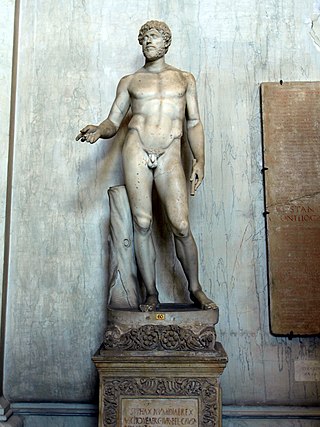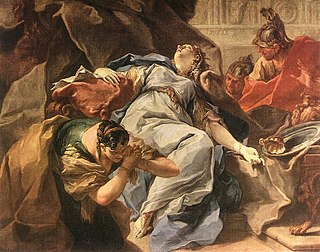Related Research Articles

The Battle of Zama was fought in 202 BC near Zama, now in Tunisia, and marked the end of the Second Punic War. A Roman army led by Publius Cornelius Scipio, with crucial support from Numidian leader Masinissa, defeated the Carthaginian army led by Hannibal.
Thomas Nabbes was an English dramatist.

Mago Barca was a Barcid Carthaginian who played an important role in the Second Punic War, leading forces of Carthage against the Roman Republic in Iberia and northern and central Italy. Mago was the third son of Hamilcar Barca, was the brother of Hannibal and Hasdrubal, and was the brother-in-law of Hasdrubal the Fair.

Syphax was a king of the Masaesyli tribe of western Numidia during the last quarter of the 3rd century BC. His story is told in Livy's Ab Urbe Condita. He ruled over a territory extending from present day Constantine to Fez.

Hasdrubal Barca, a latinization of ʿAzrubaʿal son of Hamilcar Barca, was a Carthaginian general in the Second Punic War. He was the brother of Hannibal and Mago Barca.
Gaius Laelius was a Roman general and statesman, and a friend of Scipio Africanus, whom he accompanied on his Iberian campaign and his African campaign. His command of the Roman fleet in the attack on New Carthage and command of the Roman cavalry at Zama contributed to Scipio's victories.

Sophonisba was a Carthaginian noblewoman who lived during the Second Punic War, and the daughter of Hasdrubal Gisco. She held influence over the Numidian political landscape, convincing king Syphax to change sides during the war, and later, in an act that became legendary, she poisoned herself rather than be humiliated in a Roman triumph.

The Battle of the Great Plains was a battle between a Roman army commanded by Scipio Africanus and a combined Carthaginian-Numidian army late in the Second Punic War. It was fought on the plains south of Bulla Regia around the upper Bagradas River. The African campaign of Scipio was designed as a diversionary tactic by Rome to disrupt Hannibal's attack on Italy. By defeating the Carthaginians, Scipio Africanus caused Hannibal to leave Italy and return to Africa, where he was later defeated at Zama.
Queen Henrietta's Men was an important playing company or troupe of actors in Caroline era in London. At their peak of popularity, Queen Henrietta's Men were the second leading troupe of the day, after only the King's Men.
The Battle of Cirta was a battle during the Second Punic War between the forces of the Massyli King Massinissa and the Masaesyli King, Syphax.

The siege of Utica was a siege during the Second Punic War between the Roman Republic and Carthage in 204 BC. Roman general Scipio Africanus besieged Utica, intending to use it as a supply base for his campaign against Carthage in North Africa. He launched repeated and coordinated army-navy assaults on the city, all of which failed. The arrival of a large Carthaginian and Numidian relief army under Carthaginian general Hasdrubal Gisco and Numidian king Syphax in late autumn forced Scipio to break off the siege after 40 days and retreat to the coast.

The Battle of Utica was fought in 203 BC between armies of Rome and Carthage during the Second Punic War. Through a surprise attack, the Roman commander Scipio Africanus managed to destroy a numerous force of Carthaginians and their Numidian allies not far from the outflow of the Medjerda River in modern Tunisia. Thus he gained a decisive strategic advantage, switched the focus of the war from Italy and Iberia to Carthaginian north Africa, and contributed largely to the final Roman victory.
Pathomachia, or the Battle of Affections, also known as Love's Lodestone, is an early 17th-century play, first printed in 1630. It is an allegory that presents a range of problems to scholars of the drama of the Jacobean and Caroline eras.

The Punica is a Latin epic poem in seventeen books in dactylic hexameter written by Silius Italicus comprising some twelve thousand lines. It is the longest surviving Latin poem from antiquity. Its theme is the Second Punic War and the conflict between the two great generals Hannibal and Scipio Africanus. The poem was re-discovered in either 1416 or 1417 by the Italian humanist and scholar Poggio Bracciolini.
Michael Bowyer (1599–1645) was an actor in English Renaissance theatre in the Jacobean and Caroline eras. He spent most of his maturity with Queen Henrietta's Men, but finished his career with the King's Men. With the former company, he was one of "those of principal note," according to James Wright's Historia Histrionica (1699), one of the troupe's "eminent actors."
Hugh Clark was a prominent English actor of the Caroline era. He worked in both of the main theatre companies of his time, Queen Henrietta's Men and the King's Men.
William Allen was a prominent English actor in the Caroline era. He belonged to both of the most important theatre companies of his generation, Queen Henrietta's Men and the King's Men.
Anthony Turner was a noted English actor in the Caroline era. For most of his career he worked with Queen Henrietta's Men, one of the leading theatre companies of the time.

Publius Cornelius Scipio Africanus was a Roman general and statesman, most notable as one of the main architects of Rome's victory against Carthage in the Second Punic War. Often regarded as one of the best military commanders and strategists of all time, his greatest military achievement was the defeat of Hannibal at the Battle of Zama in 202 BC. This victory in Africa earned him the epithet Africanus, literally meaning “the African,” but meant to be understood as a conqueror of Africa.

Masinissa, also spelled Massinissa, Massena and Massan, was an ancient Numidian king best known for leading a federation of Massylii Berber tribes during the Second Punic War, ultimately uniting them into a kingdom that became a major regional power in North Africa.
References
- ↑ Charlotte Moore, The Dramatic Works of Thomas Nabbes, Menasha, WI, George Banta Publishing, 1918; pp. 40–2.
- ↑ E. K. Chambers, The Elizabethan Stage, 4 Volumes, Oxford, Clarendon Press, 1923; Vol. 4, pp. 97, 156.
- ↑ Chambers, Vol. 2, pp. 166, 177; Vol. 3, pp. 302, 471.
- ↑ Chambers, Vol. 3, p. 433.
- ↑ R. W. Vince, "Thomas Nabbes's Hannibal and Scipio: Sources and Theme," Studies in English Literature 1500–1900, Vol. 11 No. 2 (Spring 1971), pp. 327–43; see pp. 327–8.
- ↑ Moore, pp. 40, 45-52.
- ↑ A. H. Bullen, ed., Old English Plays, New Series: The Works of Thomas Nabbes, 2 Volumes, London, Wyman & Sons, 1887; Vol. 1, pp. 191–2.
- ↑ Vince, p. 334.
- ↑ Vince, pp. 342–3.
- ↑ Vince, p. 343.
- ↑ L. B. Seeley, ed., Mrs. Thrale, Afterwards Mrs. Piozzi: A Sketch of Her Life and Passages from Her Diaries, Letters & Other Writings, London, Seeley & Co., 1908; p. 30.